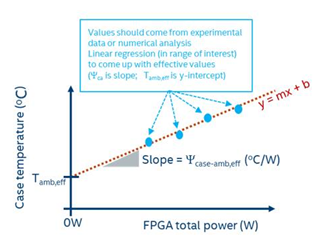7. Example 2—Alternative Method of Analyzing Thermal Design
The Thermal page of the Power and Thermal Calculator (PTC) reports the required ΨCA for the FPGA; consequently, if you can determine the ΨCA for the FPGA in question, you can then readily determine whether the system has sufficient cooling. The method of entering effective ΨCA and effective ambient temperature is especially useful for large systems where you do not want to re-run your analysis or deployed systems in the field where the cooling design is fixed. For this method you can measure the effective ambient temperature and ΨCA experimentally, or determine it by CFD analysis. In either case, the result is valid only if other components of the system—especially upstream components—are powered up as they would be in the actual system, and are not subject to change. Otherwise, ensure that you perform the analysis for maximum power of the other parts and the least cooling available.
To perform the measurement or analysis keep all the transceiver powers constant but vary the core die powers by ±25% and determine the FPGA case temperature as a function of total package power. You can then use a simple linear regression to determine the Ψcase-amb,eff and Tamb,eff for the FPGA.
